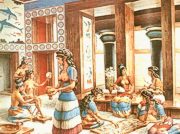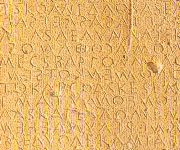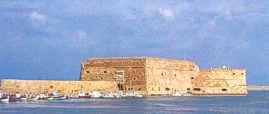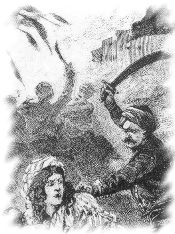History of Crete
Outlined history of the island of Crete, from Neolithic times to present days.
NEOLITHIC PERIOD (6500 - 2600 B.C)
No remains from the preneolithic period nave been found on Crete.
Before the Neolithic period, people must have lived in caves at first and supported themselves by hunting and fishing, using stone and bone tools, and they must have known how to make simple clay pots.
Later they seem to have developed a primitive agriculture and started to make clay houses on rock foundations, to tame animals and to decorate their pottery with different colors and patterns as well as making clay images of animals. The various finds made and the location of the first dwelling places lead to the supposition that this primitive civilization was not native and unique but part of the common eastern Mediterranean civilization.
PREPALATIAL (EARLY MINOAN I, II, III) PERIOD (2600 - 2000 B.C.)
During the last stages of the Neolithic period (up to about 2600 BC) this highly developed civilization reached its distinctive peak, known as the Minion Era. The people were short- the average male height was about 1.60 m. Nothing is known about commerce

during the period but it is assumed that there was trade with the nearby islands and the east.
Pottery making flourished and copper and later bronze began to be worked. Α distinctive artistic sensitivity can be recognized in the seals of that period, worked in semiprecious stones. Revising Evans, archeologists call this period until 2000 BC the
Prepalatial.
PROTOPALATIAL (MIDDLE MINOAN I, II, IIIA) PERIOD(2000 - 1700 B.C)
The period from 2000 BC to 1700 BC is called the
Protopalatial, with the construction of the first
palaces at Knossos, Phaestos and Malia, as a result of the concentration of wealth and power in the hands of the ruling families in these settlements.
Following the development of productivity, an organized and hierarchic society had already come into being, with a corresponding decline in the clan system. Increasing trade with the other Aegean islands, Egypt and the rest of Africa, Asia Minor and the entire Mediterranean led to the emergence of
Crete as a sea power.

The import, processing and re-export of metal, together with intermediate trade, amassed wealth for the island. Writing was used, in the form of
hieroglyphics, probably originating from Egypt. Work in gold and precious stones, sculpture and pottery reached amazing heights.
The palaces were destroyed, apparently by earthquakes, in 1700 BC but this did not interrupt the development of civilization, however. At about this time, a new form of writing, known as
Linear Α, made its appearance; it was probably used to record commercial and administrative matters. It has still not been decided whether the roots of this writing were Indo-European or Semitic.
NEOPALATIAL (MIDDLE MINOAN IIIB - LATE MINOAN I, II) PERIOD(1700 - 1400 B.C)
In the so-called
Neopalatial period (1700 BC -1400 BC) the palaces at Knossos, Phaestos and Malia were rebuilt on a much grander scale; they were advanced even judged by modern standards. The bulk of Minoan power was centered undoubtedly around Knossos, but the other sites in central and eastern Crete show evidence of the wealth and activity of the Minoans. Minoan society resembled a pyramid, with the farmers and workers at the base and the legendary Minos at the top.

The common people knew nothing of the luxurious and comfortable life of the palaces. Although this was not a matriarchal society,
women had a privileged place and some of them must have had considerable influence at the palace.
The Mother-Goddess, source of Life and fertility occupied first place in religion. Her symbols were the double axe, horns, birds, snakes and flowers, all of which can be seen in the large frescoes which adorn the palace, as well as on the pottery. The art of this period reaches the peak of incomparable delicacy.
During this period Crete took part in international trade and there is proof that amber was imported from the Baltic along the "amber route", across Europe. Their wealth and power gave the Minoans the confidence to build their palaces proudly, without the protection of fortifications.
By about 1500 BC a new form of writing, called
Linear Β, had come into use; archaeologists have recognized it as Greek, which shows that there was a connection between the inhabitants of mainland Greece, the Achaeans (Mycenaeans) and those of Crete.
POSTPALATIAL (LATE MINOAN III) PERIOD (1400 - 1100 B.C)
In about 1450 BC a terrible disaster laid waste all the centers of Minoan Crete.
Was it earthquake again or revolution or were the places burnt by invaders?
What is certain, however, is that new rulers were appearing in the Aegean at that time.
The last flowering of Minoan art, known as
"Postpalatial style", ended with the conquest of the island by the Achaeans. Not only did the typical Minoan characteristics vanish from society, art and religion, but Minoan grace and delicacy also disappeared from the arts and crafts of the period, which became rough and clumsy.
Knossos, Tylissos, Agia Triada and Palekastro were partly rebuilt and inhabited, while
Μinoans settled in new villages in eastern Crete at the same time.
The part played by the island in commerce, and its influence in general, was limited from then on, but Crete did take part in the Trojan War with its own army.
The Bronze Age and its world came to an end. Wars, social struggles, financial exhaustion all paved the way for the
Dorian invasion.
SUB-MINOAN PERIOD (1100 - 1000 B.C)
In about 1100 BC the Dorians - a Greek race -captured the Minoan strongholds one after the other and put an end to the Mycenaean state. Crete then came under the sway of the new rulers and so ended the last Minoan period - the Postpalatial (1400 BC to 1100 BC).
With the occupation of Crete by the Dorians armed with iron weapons, the local population was reduced to slave status. Part of the population (called
Eteocretans by the Greeks) sought refuge on the plateau of Lassithi and in the extreme east of Crete where they kept up the heritage of the Minoan language until the Hellenistic period.
DORIAN PERIOD (100 - 67 B.C)
Crete then passed into complete obscurity and the only work continued was the production of great earthenware jars (pithoi). Iron slowly took the place of bronze and in this new period it was the Phoenecians who dominated the Mediterranean. Crete re- established contact with the surrounding areas and started a new life, especially in the west of the island.
Phoenecian, Assyrian and Egyptian influence led to the substitution of the eastern style for the geometric. Crete was now just one part of the then known world and showed no sign of any particular culture of its own. The basis of the social structure of the time was land ownership. The aristocracy of great landowners formed the ruling class of the Dorians who had civil rights and lived under a socialist regime. The great families of clans came to power in turn every year and they were represented by ten noblemen who had civil, military, religious and judicial duties. Former representatives formed a senate whose power in important matters was unlimited even by the assembly of citizens. Young men underwent military training in "herds" before taking an oath. They were then grouped in companies and had their meals at common mess tables, at public expense.

The citizens were free but were obliged to enlist in the army. The farmers were divided into Perioikioi (neighbours) and serfs, according to birth.
The Dorians on Crete were especially advanced in matters of legislation, as is shown by the
laws found at Gortys. Thanks to trade, there was still some degree of prosperity on the island, which enabled the Cretan cities, already formed into independent city-states, to construct beautiful buildings and issue their own coinage. Knossos, Gortys and Kydonia ruled over the smaller settlements.
In about 300 BC six of the south-western cities formed the "Highland Confederation" which Iater formed alliances with Gortys, Cyrenaica and Pergamos. Other Cretan cities made alliances with other powers, such as Sparta and Rhodes, but these alliances were never long lasting.
Endless skirmishes, raids and wars brought the island into disrepute and at this time Crete was known as a refuge for pirates, beggars and liars. There was now no stopping the fall of Crete.
ROMAN PERIOD (67 B.C. - 395 A.D.)
The Romans arrived in Crete as mediators and settled in as conquerors. After three years' sporadic fighting, Crete became a Roman province, with Gortys as the capital of both Crete and Cyrenaica. Under Roman rule, which brought peace and some autonomy to the island, Crete enjoyed a period of prosperity, as the many Roman remains show.
FIRST BYZANTINE PERIOD (395 - 824 A.D.)
Titus, the first Bishop of Gortys. converted the population to Christianity, by order of the Apostle Paul, according to tradition. After the division of Roman Empire into western and eastern sectors, Crete came under the Byzantine sphere of influence.
During this period Christianity spread and many churches were built on Crete. One of the biggest is
Ayios Titus at Gortys (AD 600). From the political and cultural point of view, however, Crete is lacking in interest during this time.
ARAB OCCUPATION (824- 961 A.D.)
From AD 824 to 961 Crete was occupied by the Arabs. The center of the island was the fort of Rabd el Khandak, which later became known as Handax Or Candia and which is now the city of Heraklion. Apart from
coins, no remains have been found from this period. After a struggle lasting for many years, Nikiforos Fokas finally succeeded in freeing Crete from the Arabs and the
second Byzantine Period lasted from AD 961 -AD 1204.
SECOND BYZANTINE PERIOD (961 - 1204 A.D.)
Noble families from Byzantium, merchants from Europe and Christians from eastern countries settled in Crete. Attempts were made to destroy all traces of the Arabs and to bring back to Christianity all those who had become Moslems. Crete became of some significance again. When Byzantium became a victim of the 4th Crusade, Crete was granted to Boniface II, Count of Momferato, who then sold it to the Venetians.
Before they could take possession, however, the Genoese under Erico Pescatori seized the island. They built 14 forts around the island and fought the Venetian fleet for four years before finally yielding in 1210.
VENETIAN OCCUPATION (1204 - 1669 A.D.)
The Venetian occupation lasted for 450 years. Crete was divided into fiefs (feudal territories), which were handed over to Venetian colonists and entrepreneurs. They named the island and the capital city
"Candia" from the Arab name for the city; they organized and fortified and gave Crete a new

brilliance. The surviving Venetian fortifications and castles remain in good condition today. During the first half of the Venetian occupation there were many bloody uprisings against the cruel overlords and their efforts to impose their alien way of life and to convert the Cretan population from Orthodox Christianity to Roman Catholicism -starting from the top with the Archbishop and Bishops.
Even the Venetians took part in the 1363 rebellion against the imposition of taxes and the privileges demanded by Venice. Sometimes these uprisings were crushed and bloody reprisals taken and at other times they ended in compromise with concessions being made to the rebels.
Many artists and scholars had found refuge in Crete during the decline of the Byzantine Empire and after the fall of Byzantium itself. They established schools and Orthodox monasteries and literature and art flourished.
Despite the Venetian influence, Cretan traditions continued.
TURKISH OCCUPATION (1669 - 1898 A.D.)
The Turkish attempt to conquer the island started with a pirate raid against the coastal towns and in 1645 the Turks captured Chania and then Rethymnon a year later, in spite of Venetian resistance.
The siege and heroic defense of Candia (Heraklion) began in 1648 and was to last for 22 years. With bated breath, Europe watched the longest siege in history. It was the last stronghold of Christianity in the area and the Pope made a general appeal for help for the be- leaguered city. Francesco Morosini led the defense of the island but had to surrender eventually.
The Turks allowed the defenders to leave with honor and almost the entire Cretan population deserted the city, together with the foreigners. The Cretans left their island and settled on the lonian islands and in Venice and Mani. From Mani, some went on to Corsica, where a form of the Cretan dialect can still be heard today. History relates that during the battle for Heraklion the Venetians and their allies lost 31.000 men and the Turks lost 118.000.

Crete was then shared out among the pashas, with the exception of Sfakia which, although it paid a symbolic tax to the Turks, remained independent and became a refuge for insurgents and persecuted Cretans. Although relatively few Turks settled on the island, a great many Christians were forced to become Moslem in order to survive and many more had to leave the cities for the mountains. This was a result of declining agriculture and trade caused by the weak administrative organization of the Turks and of the ever-increasing taxes and tarrifs arbitrarily imposed on the local population.
Under these inhuman conditions, nobody had any inclination to work and this in turn made the terrible position of the local inhabitants even worse, while earthquakes and uprisings destroyed the villages.
The first great uprising took place in 1770, led by the Sfakian, Daskalogiannis. When the Greek Revolution started in 1821 , Crete rose too but was shameful abandoned by the Great Powers and ceded to the Egyptians, who had been called in by the Turks to help them. The Turks took over again in 1840, but the Cretans did not give up and the revolution continued, with its unsparing outpouring of blood. The years 1866-69 stand out particularly, as does the typical, stirring example of the
holocaust of Arkadi.
SEMI AUTONOMY - UNION WITH GREECE (1898 - 1941 A.D.)
The Great Powers finally intervened in 1898 and Crete became independent under their guarantee; with a High Commissioner, Prince George, younger son of the King of Greece. In 1905 the Cretans rose again, led by
Eleftherios Venizelos, this time because they wanted
union with Greece. Prince George was compelled to resign.
Union finally came in 1913 and so together Crete and Greece faced the consequences of World War I and the catastrophe of Asia Minor.
GERMAN OCCUPATION (1941 - 1945 A.D.)
No sooner had the island begun to recover and even to prosper, than World War II began. In 1941 select German paratroopers invaded Crete from the air; during the
Battle of Crete the Cretans, both men and women, fought magnificently and inflicted extremely heavy casualties on the Germans. For four years Crete was occupied once again, but the island fought on in spite of forced labour, starvation, inhuman cruelty, the burning of entire villages and the execution of thousands of Cretans. One impressive page of the Cretan resistance was written when General Kreipe was kidnapped. The last Germans left Crete in July 1945 and the long-suffering island was free again.
POST WAR (1945 A.D. - TODAY
Crete avoids worst of Greek civil war. Economic development and exploitation of touristic and archaeological resources hit full stride.